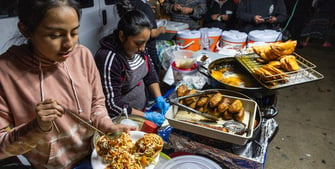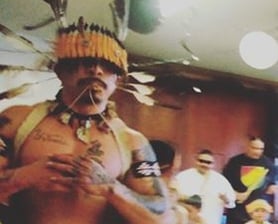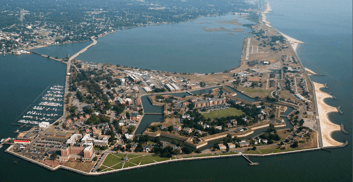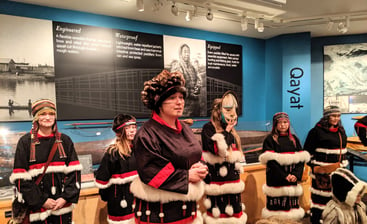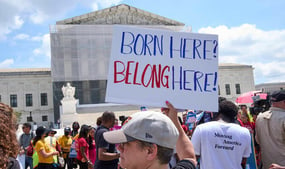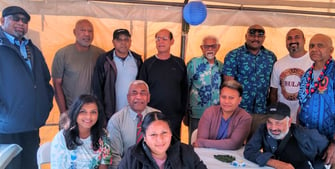Welcome
Oji African American Diaspora Blog
Racial/Cultural/Ethnical Diversity of People in The U.S.
When the Explorers, Navigators, Conquistadors, Fishermen, Slaves first ventured from the Old World of Europe, Africa and Asia into the New World of North America's present-day United States, there were many nations and tribes off American Indians occupying the territory. Today, the United States Government, recognizes 574-American Indian tribes and Alaska Native entities in the U.S. The first Europeans to reach the mainland of North America (Vineland) in what is now Maryland or Virginia in the United States or lands around the Gulf of St. Lawrence, in Canada., was Viking explorer Leif Eriksson and his party, circa 11-century AD.
The first Hispanic to explore the United States was Spanish Conquistador/explorer Juan Ponce de León's expedition to Florida in 1513. The first Hispanic settlement in the United States was established at St. Augustine, Florida on September 8, 1565, by Pedro Menéndez de Avilés. The first Asian immigration to the United States were Philippine sailors aboard a Spanish galleon who arrived at Morro Bay, California in 1587, and the first Asian settlement in the United States was established by Philippine sailors at St. Malo near New Orleans, Louisiana circa. 1763.
The second European to visit present day United States was Sir Francis Drake, who on June 5, 1579, made landfall at South Cove, Cape Arago, Oregon, and on July 23, 1579, his ship anchored at the Farallon Islands, off the coast of San Francis, California. European English Captain Christopher Newport of the Virginia Company of London established the Colony of Jamestown, Virginia on May 4, 1607.
The first Africans to arrive in the United States were “20 and odd"” enslaved African Angolans kidnapped by the Portuguese and sold to the colonists at Jamestown, Virginia on August 20, 1619. The first legally sanctioned free African settlement in the United States was Fort Mose, Florida, established when Spanish Governor Manuel de Montiano ordered its construction in 1738. The Fort was then led by an escaped African slave who had been baptized in the Catholic Church as Francisco Menéndez.
When Alaska became a state on January 3, 1959, the United States recognized the Alaska Natives, which includes the Aleuts, Inupiat, Yuit, Athabascans, Tlingit and Haida. When Hawaii became a state on August 21, 1959, the United States recognized the Native Polynesian Hawaiians.
Federally Recognized Indian Tribes
The Cahto (Kato), are an Indigenous Californian group of Native Americans. Today most descendants are enrolled as an federally recognized tribe, residing on the Cahto Indian Tribe of the Laytonville Rancheria, and a small group of Cahto are also enrolled in the Round Valley Indian Tribes of the Round Valley Reservation. The Laytonville Rancheria was established in 1908. It was created when the United States purchased 200 acres of land from missionaries for the Cahto Tribe, under the authority of the Act of June 21, 1906. The rancheria is located three miles west of Laytonville in Mendocino County, California, and is currently 264 acres in size, The term Cahto (Kato) means "People of the Lake" or "Lake People," and may derive from the Northern Pomo word for "lake", which referred to an important Cahto village site, called Djilbi. As such, the Cahto are sometimes referred to as the Kaipomo or Kato people. The Cahto (Kato) previously called themselves Tlokyhan, or "Grass People." Today they use the term Kooʾyoohaangn or Cahto Tribe as their tribal designation. The Cahto (Kato) originally lived farthest south of all the Athapascans (a group of indigenous Indians) in California, occupying Cahto Valley and Long Valley, and in general the country south of Blue Rock and between the headwaters of the two main branches of Eel River. In the early 18th century, the Cahto lived in approximately 50 village sites, some organized into bands, including "Yew Sticks Out Place village," "2nd Streeter Creek village," "2nd Prairie Creek village," and "Mud Springs Creek Mouth village." Each village had one or two headmen, but decisions were generally made by the village elders. The Cahto (Kato) shared many cultural aspects with the Yuki native Indians, including subsistence practices like gathering acorns, roots, and hunting. European explorers and settlers began exploring California in the late 18th century, but some tribes in the remote interior regions of California, where the Cahto traditionally lived, did not encounter non-natives until the mid-19th century. Many of the social practices of the Cahto tribe show how strongly they were influenced by the culture of northern-central California. Children of both sexes at the age of puberty, were required to observe certain rites. Annually in midsummer, boys were led out to a solitary place by two men, where they received instructions in mythology and the supposed origin of customs. In the winter, these boys assembled again in the ceremonial house and remained there during the four winter months for instructions on tribal folklore. A girl, at puberty, began to live a very quiet and abstemious life for five months, remaining always in or near the house, abstaining from meat, and drinking little water. She was not permitted to work, lest she catch a cold. Marriage was carried out, without consulting anyone else. Having secured a girl’s consent, her lover would sleep with her clandestinely at night, and at dawn sneak away. The girl’s parents would only learn of their daughter’s marriage in an indirect fashion. The marriage no longer a secret, the young man might erect a house of his own. The couple would separate as their choice, and children were not regarded as belonging to either the paternal or to the maternal side. The religion of the Cahto (Kato) tribe are grouped around two deities: Chénĕśh or T'cenes, the creator, and his companion, Nághai-cho or Nagaicho, the Great Traveler. The creator, Chénĕśh, who is identified with thunder and lightning, dwelt in the sky. Below the creator was an expanse of water, with a rim of land in the north. With his companion, Nághai-cho, the creator descended below and turned a monstrous deer into land. Chénĕśh created the people, but Nághai-cho made the mountains and the streams. In everything, Nághai-cho tried to outdo Chénĕśh, playing the role of the buffoon and trickster.
Cahto (Kato) Indian Tribe of the Laytonville Rancheria
Pacific Islanders
Africans
Spanish/Latino/Hispanics
Asians
Iraqi Americans Living the American Dream in Michigan
Angolan Americans are an ethnic group of people of Angolan descent or are Angolan immigrants. The actual number of Angolan Americans is difficult to determine, as many African-Americans are descendants of Angolan enslaved people. In 1644, most of the 6,900 slaves bought on the African coast came from the established stations in Angola. These African slaves were brought to New York City (Dutch Colony of New Amsterdam) by the Dutch West India Company, who were a dominant European slave trader in Africa during this period. From the 17th-century to the early 19th-century, many Angolans were transported via the Atlantic slave trade to the United States. The first Africans in Virginia were a group of "twenty and odd" captured Angolans that were landed at Old Point Comfort in Hampton, Virginia in late August 1619. Their arrival is seen as a beginning of the history of slavery in Virginia and British colonies in North America. The landing of these captive Africans is also seen as a starting point for African American history, given that they were the first Black people in mainland British America. In 1621, Anthony Johnson, a former slave from Angola, arrived in Virginia and became the first documented Black slave in the Thirteen Colonies to earn his freedom and, in turn, own slaves himself. Anthony Johnson became a successful farmer, and by 1651, he owned 250-acres and the services of five indentured servants (four white and one black). During the colonial period (1490-1776), people from the Congo-Angola region made up 25% of the slaves in North America. Delaware, Indiana, Georgia, South Carolina were among the colonies to import slaves from the Congo-Angola region. In 1739, an Angolan named Jemmy, led a group of 20 Angolan slaves in the Stono Rebellion, an uprising in South Carolina. The slave uprising killed at least 20-White settlers and several children before being harshly repressed. Large-scale Angolan immigration to the United States began in the 1970s, fleeing regional wars in their country. According to Euronews.com, there are an estimated 12-million Americans in the United States of Angolan descent, and are descendants of Angolan immigrants. Most Angolan immigrants in the U.S. are single men or small family groups, with the largest populations in Massachusetts, Pennsylvania, Connecticut, New Jersey and Maine (Wikipedia).
Guatemalan Americans are people of full or partial Guatemalan descent. The Guatemalan American population in 2021, listed approximately 1.8 million people of Guatemalan origin living in the United States. Guatemalans are the sixth largest Hispanic group in the United States, and have been migrating to the U.S. since the 1930s and 1940s. Along with other Central Americans they first arrived by way of Mexico and settled in urban areas like California, New York, Florida, and Texas. The largest influx of Guatemalans into the United States, however, didn't start until the 1970s and 1980s, peaking in the 1990s due to the Guatemalan Civil War, which ended in 1996. Tens of thousands of documented and undocumented Guatemalan refugees moved into the United States via Mexico. In the 1970s, Guatemala experienced a culmination of factors that decreased their ability to uplift themselves from poverty. The Guatemala infant mortality rate between 1970–1973 was around 82%. These circumstances included an increasing unemployment rate, as well as decreasing wages and opportunities in the rural sector. In 1976, Guatemalans experienced an earthquake that left many homeless. These factors combined with the general violence caused many Guatemalans to look toward internal, intraregional, and international migration throughout the 1970s and 1980s. From 1981 to 1983, the Guatemalan government responded to actions of Unidad Revolucionaria Nacional Guatemalteca revolutionary groups with military action, which included the genocide of 150,000 civilians. Ultimately, this formed a ripple effect, which led to displacement and migration to both Mexico and the United States for many Guatemalans. After September 11, 2001, new laws were enacted in Mexico limiting immigration visas and introduced other measures on the southern Mexican border through Plan Sur, a binational treaty with the Guatemalan government. Guatemalan Americans are a very culturally diverse group of people, including around 23-distinct ethnic groups, with different languages. The groups are, on the whole, Maya. The Ladino are a different group that speak the Spanish language and have Spanish culture. So, Guatemalan Americans are a multicultural community. This reason is why the assimilation processes, traditional beliefs, and customs vary differently between groups (Wikipedia).
Iraqi Americans are people of Iraqi descent. According to the United States Census Bureau, as of 2023, the number of Iraqi Americans in the United States is around 155,055. According to the Bureau of Citizenship and Immigration Services, 49,006 Iraqi foreign born people immigrated to the United States between 1989 and 2001 and 25,710 Iraqi-born immigrants naturalized in the U.S. between 1991 and 2001. Following the Iraq War (2003-2011), with invasion of Iraq by the U.S., there was, according to the Human Rights Ministry of the Iraqi government, a recorded 250,000 Iraqi deaths between 2003 and 2011. A significant number of Iraqis immigrated to the United States, primarily as refugees of the War. Many Iraqis who had worked with the U.S. military or government sought refugee status due to safety concerns and instability in Iraq. Iraqi immigrants in the U.S. are a significant diaspora, with an estimated 200,000 to 400,000 individuals of Iraqi descent residing in the country. The largest and oldest Iraqi community in America is Chicago, Illinois, home to the largest Assyrian population in the U.S. In the mid-1970s, nearly 1,000 Iraqi-born Assyrians were resettled in Chicago as refugees from the Lebanese Civil War. And throughout the 1980s and 1990s larger groups of refugees immigrated to the U.S. to escape the Iran-Iraq War (1980). After the Persian Gulf War, (1990-1991) a new wave of Arabs migrated to Chicago from southern Iraq. Many of these new arrivals were prisoners of war who were flown to the U.S. from Saudi Arabia, and a large portion were Muslim Shi‘a who had staged a failed uprising against Saddam Hussein in 1991. Arabs constitute the second largest group of Iraqi migrants to Chicago. Highly educated Muslim Arabs have entered a range of professional occupations. One of the oldest Iraqi communities in the U.S. follow Judaism, and who began to emigrate to the American Continent at the turn of the 20th-century. Members of the Iraqi Jewish community are driven by ambition to succeed in businesses and as professionals, and this urge has been taking precedence over most other aims in life apart from family cohesion and religious observance during the High Holidays. Iraqi American culture is a blend of traditional Iraqi customs and the American way of life. Family, religion, and community play central roles, with strong emphasis on respect for elders and a deep connection to their heritage. While adapting to American society, Iraqi Americans also strive to maintain their cultural identity through various community and religious institutions (Wikipedia).
Immigrant Diasporas & Eventual Citizens In The United States
United States Policy to Enter Country As Refugee, Migrant, Immigrant, Asylee
Reservations, Villages & Diaspora(s) in The United States
20 & odd Angolan Slaves Arrive at Point Comfort, Virginia in 1619
Federally Recognized Alaskan Natives
Alutiiq Tribal People of Native Village of Old Harbor, Alaska
Pacific Islanders - Hispanics - Africans - Asians - Europeans - Immigration
Guatemalan American Night Market Street Venders Create Piece of Home
Immigrants & Immigration
Birthright Citizenship in the United States
Birthright citizenship in the United States, also known as jus soli, is the principle that "Anyone born in the United States is automatically granted U.S. citizenship, regardless of their parents' immigration status". This article is enshrined in the Fourteenth Amendment (History), of the Constitution, which states: "All persons born or naturalized in the United States, and subject to the jurisdiction thereof, are citizens of the United States and of the State wherein they reside". The foundation of birthright citizenship, adopted in 1868, was primarily to ensure citizenship for newly freed Black slaves after the American Civil War/War Between The States (Wikipedia). The Supreme Court case United States v. Wong Kim Ark (1898) confirmed that the Fourteenth Amendment's citizenship clause, extends to those born in the U.S. to foreign nationals. There are very narrow exceptions to birthright citizenship, such as children born to foreign diplomats or children born to members of hostile occupying forces. People born in unincorporated territories like American Samoa are considered "non-citizen nationals" unless granted citizenship by Congress. Despite legal protections, racial discrimination and disparities persist in various aspects of citizenship and rights, including access to education, housing, and employment. And other debates continue about citizenship, including the status of undocumented immigrants and their children, and the interpretation of the Fourteenth Amendment's "subject to the jurisdiction" (U.S. Congress), clause. On January 20, 2025, President Trump signed Executive Order 14160: "Protecting the Meaning and Value of American Citizenship" (Federal Registry), to restrict automatic citizenship at birth for certain individuals born in the United States. This includes children born to mothers unlawfully present in the U.S. or those with temporary legal status, where the father was not a U.S. citizen or lawful permanent resident. The order asserts that such individuals are not fully "subject to the jurisdiction" of the U.S. under the Fourteenth Amendment and should not be automatically granted citizenship. The Supreme Court in a 6-3 decision, written by Justice Amy Coney Barrett, along ideological lines on June 27, 2025, sided with the Trump administration's request to limit universal injunctions issued by federal courts. At issue was how the lower courts should handle President Trump's executive order, which declared that the children of parents who enter the U.S. illegally or on a temporary visa are not entitled to automatic citizenship. The majority opinion didn't rule on whether Trump's executive order violates the 14th Amendment or the Nationality Act. Instead, it focused on whether federal courts have the power to issue nationwide blocks. "Universal injunctions likely exceed the equitable authority that Congress has given to federal courts." "The Supreme Court grants the Government's applications for a partial stay of the injunctions entered below, but only to the extent that the injunctions are broader than necessary to provide complete relief to each plaintiff with standing to sue." (NPR News)
Melanesian Fijian Americans in CA Celebrate Fiji Independence Day
Europeans
Czech Americans Celebrate Czech Heritage in Nebraska
The Alutiiq (Sugpiaq) people are as of 1968, a United federally recognized Alaska Native group inhabiting the southern coast of Alaska, specifically the Kodiak Island Archipelago. They have a rich history and culture rooted in their connection to the land and sea, with a deep respect for their traditions and community. According to the Old Harbor Native Corporation, although the name Alutiiq is a legacy of Western colonization, the Alutiiq people refer to themselves as Sugpiaq, meaning "the real person." The Alutiiq have inhabited their traditional lands, the coastal environments of south-central Alaska, which includes Prince William Sound, the outer Kenai Peninsula, the Kodiak Archipelago, and the Alaska Peninsula for more than 7,500 years. Afognak Native Corporation represents over 1,000 Native Shareholders, who are descended specifically from the Village of Afognak, on Afognak Island, in the northern part of the Archipelago. Afognak Native Corporation’s wholly owned subsidiary, Alutiiq, LLC, is named after the Alutiiq people. The Alutiiq culture is deeply intertwined with the land and sea, with a subsistence lifestyle focused on marine mammals, fish, and migratory birds. The Alutiiq Tribe of Old Harbor holds a rich culture with spiritual ties to the land, bonds of kinship and belief, respect for Elders and community and the shared practices of a subsistence lifestyle. Traditional Alutiiq villages are characterized by sod-covered houses called ciqlluaq, and partially built underground. Many Alutiiq people continue to live in their traditional homelands, practicing subsistence hunting and fishing (Alutiq Museum). The Alutiiq people are indigenous people of the Kodiak Island Archipelago. The Kodiak Archipelago is located south of Anchorage in the Gulf of Alaska. The Alutiiq people have typically been defined by their connection to land and sea. Traditionally, the Alutiiq people lived in villages, and their houses, called ciqlluaq, were sod-covered structures built partially underground. Each person held a position within the community and was responsible for some aspect of life, be it hunting, fishing, cooking, sewing, or gathering. Everyone was important and had a role in the village’s survival. Traditionally the Alutiiq people’s primary food sources were marine mammals, fish, and migratory birds. These were hunted from kayaks with atlatls (throwing boards) and spears or fishing hooks. Subsistence activities were, and continue to be, the fundamental foundation of their culture. From 1732 to 1867, the Russian Empire (Wikipedia), laid claim to northern Pacific Coast territories in the Americas, collectively known as Russian America. In April 1784, Russian fur trader Grigory Shelikhov (Wikipedia), found a settlement on Kodiak Island. The Alutiiq people initially resisted, and fled to the secluded Stack island Refuge Rock across Old Harbor in the Kodiak Archipelago. But the Russians attacked the people on the island by shooting guns and cannons, slaughtering an estimated 200 to 500 men, women and children on Refuge Rock. In August of 1784, Russian fur trader Grigory Shelikhov (Wikipedia), and his men claimed Kodiak as the capital of Russian America. To the Alutiiq, Refuge Rock is known as Awa’uq (to become numb). The final battle at Refuge Rock represents a dramatic change in the lives of the Alutiiq people, the loss of their sovereignty and lands under Russian subjugation. During Russian control of the Kodiak Archipelago, Alutiiq people were forced to hunt and prepare food for Russian use. In 1867, the United States purchased Alaska for $0.02 an acre from Russia. However, Alaska Native people were not allowed to vote until the Indian Citizenship Act of 1924, and it was not until January 3, 1959 that President Eisenhower signed the proclamation admitting Alaska as the forty-ninth state (Afognak).
"Be Aware of The Evils of The Devil - But Learn & Follow The Commandments of Almighty God"
To
Melanesian Americans are people of Melanesians (Wikipedia), and are the predominant and indigenous inhabitants of Melanesia, an area stretching from New Guinea to the Fiji Islands. According to USAFacts, there are likely around 56,538 Melanesians in the United States today. This includes 52,801 Fijians and 3,737 people from other Melanesian groups, not including those who may identify as Melanesian in combination with other ethnicities. Melanesian Americans, of Fijian descent, are predominantly found in California, however, smaller communities of Melanesians of various origins, including New Caledonian, Papuan, Vanuatuan, and Solomon Islander, can be found in other parts of the U.S. The name Melanesia, was derived from Greek, meaning "islands of Black people," and Melanesians are known for their dark skin and, in some cases, blonde hair. Melanesians, like other populations with dark skin, have evolved this characteristic as an adaptation to high levels of ultraviolet (UV) radiation in their environment, particularly in tropical regions near the equator. Melanin, the pigment that gives skin its color, acts as a natural sunscreen in regions with intense UV radiation, such as Melanesia. Darker skin with more melanin helps to protect against the harmful effects of UV, such as skin cancer. When ancient populations migrated to areas with less UV, lighter skin evolved in them as an adaptation to facilitate vitamin D production. Melanesians are descendants of early human migrants who likely retained the ancestral dark skin characteristic in their environment. Another unique genetic trait among Melanesians is the presence of blonde hair, which is caused by a different gene than the one responsible for blonde hair in Europeans. A cystine-to-arginine change at a highly conserved residue in tyrosinase-related protein 1 (TYRP1) as the single source of blond hair in Melanesian Solomon Islanders. This missense mutation is predicted to impact catalytic activity of the protein and causes blond hair through a recessive mode of inheritance. In a New York Times article, science writer Carl Zimmer explains that Melanesians are descendants of the Denisova hominin human subspecies. The Denisovans are considered cousins of Neanderthals, with both groups having migrated out of Africa around 400,000 years ago. The Neanderthals migrated into Europe while the Denisovans moved towards Southeast Asia.
Czech Americans are citizens of the United States whose ancestry wholly, or partly originate from the Czech lands, namely Bohemia, Moravia and Czech Silesia. Germans from Czech lands who emigrated to the U.S. are identified as either German Americans, or, as Americans of German Bohemian descent. In 2019, according to the U.S. Census Bureau, there are 2-million Americans of full or partial Czech or Slovak descent (Wikipedia). Many of these individuals are descendants of Czech immigrants that settled in more rural parts of the country and, as a result, have developed their own unique culture that blends their Czech heritage with American traditions. Czechs are a Slavic people, closely related to the Slovaks in speech and custom, but with a distinct history and national identity. The term "Czech" denotes the inhabitants of historic Bohemia, Moravia, and Silesia, while "Slovak" is reserved for the people who settled on the southern slopes of the Carpathian Mountains, located in Romania and Serbia. Prior to the 19th-century, few Czechs had immigrated to the U.S., and evidence of their presence during the colonial and revolutionary periods is sketchy. Augustine Hermann (Czech Center Museum Houston), one of the founders of the Virginia tobacco trade and compiler of the first map of Maryland and Virginia, is thought to be the first Czech immigrant. In 1638 Czech Protestant exiles, who had set sail for America in the service of the Swedish army, assisted in the building of Fort Christina (Brunswick County) on a tributary of the Delaware River. The first major immigration wave to the U.S. occurred in 1848, when 4,000 t0 10,000 Forty Eighters (Wikipedia), German political refugees from Czech lands fled to the United States to escape political persecution by the Habsburgs. At the turn of the century, Czech immigrants were more likely to make the journey to the U.S. with their families. Moreover, it was not uncommon in large Czech families for the head of the household to make more than one trip to the U.S., bringing with them one or more children each time. By 1900, there were 199,939 American-born Czechs as opposed to 156,640 Czechs who had been born in Europe. The number of Czechs entering the country was reduced by the temporary Emergency Quota Act (Immigration History) of 1921, and the National Origins Act (Library fiveable) of 1924. Between 1946 and 1975, 27,048 Czechs immigrated to the U.S., and with the Communist takeover of Czech in 1948, these refugees, many of them students, teachers, journalists, and professional people, began pouring into the U.S. Beginning in the 1990s, the number of foreign-born Czechs in the U.S. has been decreasing, and with the collapse of Communism in Eastern Europe, Czech immigration to the United States has significantly slowed (Every Culture).
“We have overcome economic devastation, defeated mighty oppressors, and lifted up generation after generation of Americans. We can, and we will, do it again. For that is your birthright as members of the American family: White, Black, Hispanic, Asian, Immigrant, or descendant of the Founding Fathers”
Quote: Brian Keith Sandoval - American Politician, Academic Administrator, & Former Federal Judge
Quote: Brian Keith Sandoval - American Politician, Academic Administrator, & Former Federal Judge
This Blog Site Was Created Using Hostinger
This Blog Site is Online Using AT&T Internet
Oji Okaome, Blog Administraor & Editor



